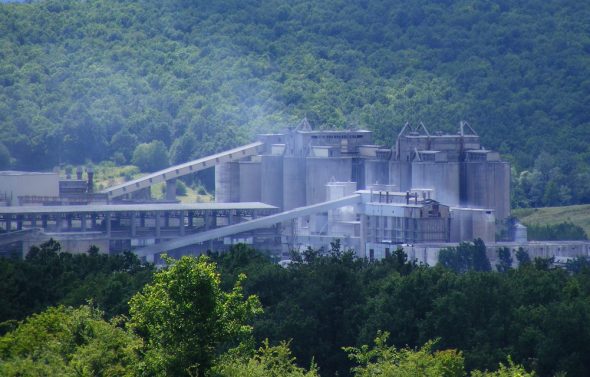NSF, DOE grants fund UIC research to decarbonize cement manufacturing
Chemical engineers at the University of Illinois Chicago are investigating new methods to reduce carbon dioxide emissions from cement manufacturing.
Cement is one of the most widely used building materials, but its production is responsible for up to 8% of global emissions from carbon dioxide, representing a major challenge to the goal of reducing climate change. Despite ongoing efforts to research renewable energy options and new cementation methods, there is currently no clear pathway to carbon-neutral cement manufacturing.
Now, thanks to two federal grant awards, UIC researchers and their collaborators from the University of Wisconsin-Madison and Pennsylvania State University are hoping to change this fact.
“We have a global problem with C02 emissions, and if you look at all the industrial processes and rank them from highest to the lowest in terms of producing C02, cement manufacturing is at the top,” said Meenesh Singh, assistant professor of chemical engineering at the UIC College of Engineering. “We cannot just stop using it because cement is so crucial for creating buildings, infrastructures, roads and many other places.”
One award, from the Department of Energy, will provide $2.3 million in support of research to develop a carbon-negative replacement for portland cement, the most commonly used type of cement.
“We hope to turn the widely used and previously carbon-intensive building material into a carbon capture system,” said Singh, co-principal investigator of the DOE award.
The funding is awarded through the Harnessing Emissions into Structures Taking Inputs from the Atmosphere program, which was created to support the development of technologies that cancel out embodied emissions while transforming buildings into net carbon storage structures.
Singh’s research group will collaborate with scientists from UW-Madison and Penn State on the grant. The proposed project from the three universities uses carbon captured from the air through a process called distributed direct air capture with rapid mineral carbonation to convert industrial mineral wastes such as coal ash into a recyclable replacement for portland cement. The objective is to create a durable and versatile building material that permanently stores C02 through a process that pulls more carbon out of the air than is emitted.
“What we have done with this idea is take a waste material that we then make into a castable cement-like material, which does not release C02 but actually captures it,” Singh said.
UIC is working on a high-throughput system that can test different types and levels of chemicals, which can be used with varied waste materials.
Another award, $1.9 million from the National Science Foundation to UIC, UW-Madison and Fort Lewis College, will support the development of a sustainable way to produce calcium hydroxide, a critical ingredient for creating cement.
The process under development is known as LoTECH, for low-temperature calcium hydroxide process. It uses a low-temperature ammonia cycle to produce calcium hydroxide from industrial waste streams, such as crushed concrete and coal ashes. As a result, cement could be made into concrete in small, distributed plants or portable units, Singh said.
The LoTECH system also has potential to shorten supply chains and promote sustainability in the concrete industry, he said.
“You can think of this as a closed-looped, modular process,” said Singh, co-principal investigator of the NSF award. “It can be placed in the back of a truck, and wherever you have a supply of concrete after a building is demolished, this system can harvest the waste product and then manufacture new cement right on site.”
Singh added that sustainable calcium hydroxide could replace the traditionally used limestone as the calcium source, which offers a realistic way to quickly lower the carbon footprint of the existing cement industry by more than 50% by eliminating the thermal decomposition of limestone.

